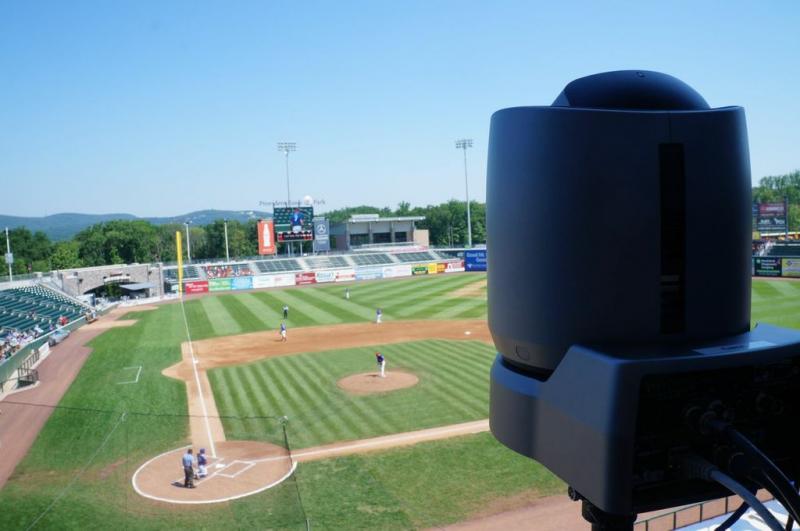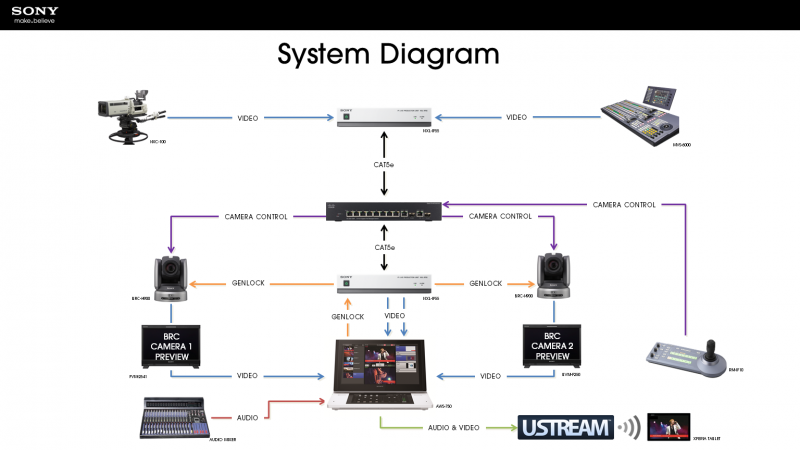'Boulders' look to live production over IP
The Rockland Boulders, a CanAm League semi-professional baseball team, provided the perfect setting for a demonstration of a new live production system from Sony that allows organizations with limited budgets like the Boulders to inexpensively produce and stream a live switched multi-camera production of a game using a tablet-style touch-screen interface. The system was comprised of Sony’s new Anycast Touch all-in-one production system that uses a touch-screen interface to manage different elements of a live production, two Sony BRC-H900 remotely controlled HD cameras over an IP-based CAT-5 cabling infrastructure, and the Sony NXL-IP55 IP Live Production unit which can transmit four channels of full HD video over IP network infrastructure with ultra-low latency.
The ballpark also features a well-equipped HD-SDI (1080i) control room, complete with a Sony MVS-6000 production switcher, and Sony HD cameras strategically located around the field that feed the in-stadium video screens, but the system displayed gets a separate switched production — driven by virtually anyone with minimal technical experience — on the Internet for those who can’t attend games.

Live switching of IP signals has been problematic in the past, but Sony has developed new control protocols and ways of structuring the packets to ensure the delivery of high-definition images over an existing Ethernet network.
Using the IEEE 1588 Precision Time Protocol (PTP), a dedicated transmitter/receiver unit (the Sony NXL-IP55) time stamps the video packets — creating a master clock that all cameras can genlock to, for lack of a better word, in order to ensure that they are in sync with other cameras as part of a multi-camera production. It’s critical that all camera feeds are properly synchronized.
“If you screw up the timing and don’t synchronize the cameras, you can’t accurately reconstruct the video at the receive end,” said Hugo Gaggioni, Chief Technology Officer and Vice President, Sony Electronics, who introduced the idea at various conferences last year. “That’s why time stamping the packets is so important.”
Although the team currently uses a TriCaster system from NewTek, the games could be streamed live over the Internet with an Anycast Touch (model AWS-750) in tandem with a Sony RM-IP10 camera joystick controller. The production could include up to four video streams (three downstream and one upstream, or two downstream/two upstream), The input and output could be handled over the stadium’s existing IP network, using a NXL-IP55 unit at either end (one serving as a transmitter and the other a receiver). This allows multiple video data streams to be transmitted over the ballpark’s IP local area network (LAN). The NXL-IP55 converts HD-SDI signals from the in-stadium cameras to IP for distribution back to the control room, where they are changed back to HD-SDI for switching and editing.
Leveraging a stadium’s existing Ethernet backbone could saves a team money in installation costs and time to get it up and running. (Sony engineers set up a temporary though fully operational two-way system in the stadium with two 300ft Cat-5 video cable runs and an audio cable in a about an hour.)

The Sony VISCA protocol is used to control the pan, tilt and zoom functions of the BRC-H900 remote cameras. VISCA is a set of professional camera control commands used with PTZ cameras that works with several of Sony’s surveillance and OEM block cameras. It’s based on RS-232 serial control at 9600b/s, but can also support 8-Pin DIN, RJ45 and RJ11 connectors used in daisy-chain configurations. Sony said distance limitations (about 300m) could be overcome by piggybacking onto a fiber-optic camera cable if necessary. The company also said that the NXL-IP55 generates less than a field of delay at the receive end — which is vastly improved over earlier versions of video-over-IP switching systems. This low latency, said Sony representatives, is barely noticeable to the naked eye.
With its tablet-like touch screen interface, the Anycast Touch system can produce full HD (1920x1080) content with 10-bit processing to produce extremely clear, highly detailed pictures either in SD, HD or a mix of both. It combines a video switcher, audio mixer, special effects generator, PTZ camera control, a real-time streaming encoder, image still store, character generator, and scale converter. It’s got a tilt-screen capability that allows the two dual screens to split video and audio controls. Operators can also store settings (including titles, logos and effects) in scene folders that can be automatically called up during a live production with the simple press of a button. Video sources are accessed and manipulated by touching a related thumbnail picture.
Get the TV Tech Newsletter
The professional video industry's #1 source for news, trends and product and tech information. Sign up below.
